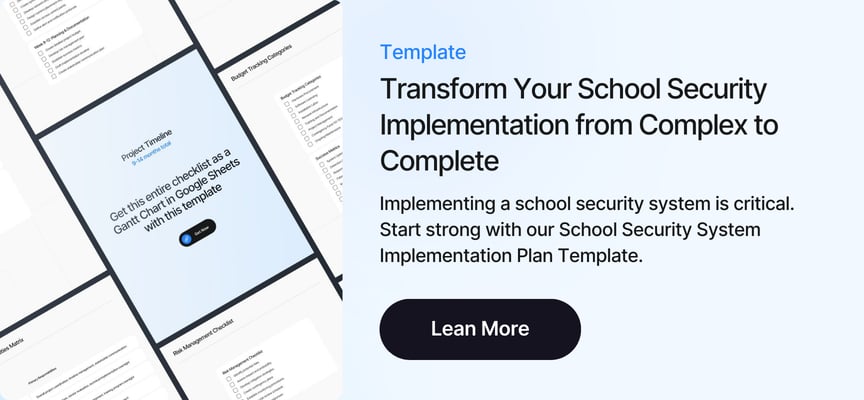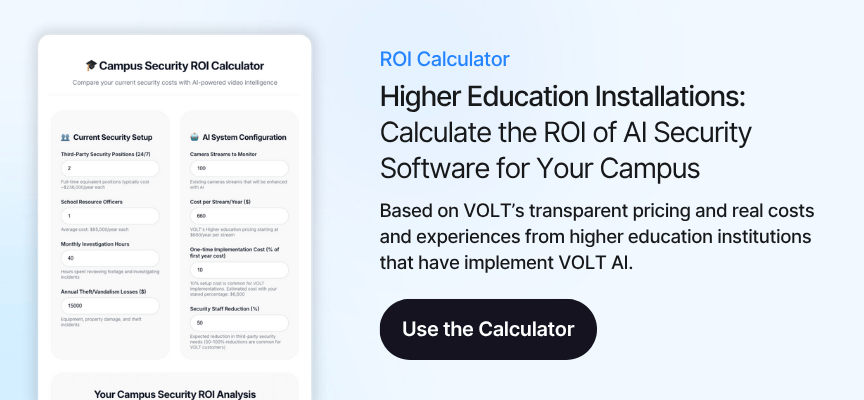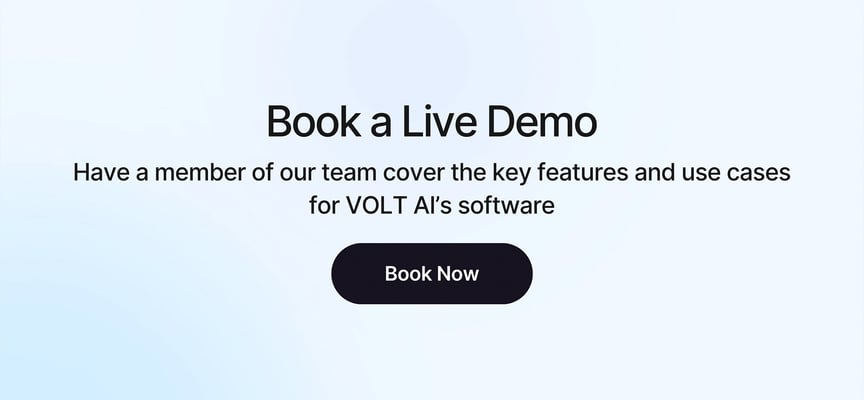Key Points
- AI-powered school safety solutions: Transform existing camera infrastructure into intelligent monitoring networks that detect threats in real-time
- Integrated communication platforms: Streamline emergency response through automated alerts and coordinated notification systems for comprehensive school security
- Multi-threat detection capabilities: Address weapons, medical emergencies, and behavioral incidents through unified school safety technology platforms
- Strategic implementation: Successful deployment requires careful planning, staff training, and integration with existing security protocols
- Cost-effective scalability: Modern school safety solutions work with current infrastructure while providing room for future expansion
What Are Modern School Safety Solutions?
School safety solutions are comprehensive technology systems that protect educational institutions through AI-powered monitoring, threat detection, and emergency response coordination. These solutions have transformed dramatically over the past decade, evolving from reactive measures and manual monitoring to sophisticated, proactive systems that prevent incidents before they escalate.
Modern school safety solutions integrate multiple technologies into cohesive platforms that protect students and staff around the clock. These systems combine artificial intelligence, advanced communication networks, and intelligent monitoring capabilities to create comprehensive safety ecosystems. The result is a fundamental shift from responding to incidents after they occur to preventing them through early detection and rapid response.
Educational institutions face complex safety challenges that require sophisticated responses. School administrators must balance creating welcoming learning environments with implementing robust security measures. This challenge demands solutions that enhance safety without compromising the educational mission or student experience, which is why school safety is important for creating effective learning environments.
Read the full school safety guide.
AI-Powered Video Intelligence: The Foundation of Comprehensive School Safety Solutions
Artificial intelligence represents the most significant advancement in school safety technology. AI-powered video intelligence systems analyze camera feeds continuously, identifying potential threats and unusual activities in real-time. These school security systems transform existing security cameras into intelligent monitoring networks that never tire or lose focus.
Modern AI systems excel at detecting multiple threat types simultaneously. Weapon detection capabilities identify firearms and other dangerous objects even when partially concealed. Fight detection algorithms recognize aggressive behavior patterns and physical altercations as they develop. Medical emergency detection identifies when individuals fall or show signs of distress, enabling rapid response to health crises.
Advanced Detection Capabilities in School Safety Solutions:
- Weapon identification: Recognizes firearms, knives, and other threatening objects in various lighting conditions and angles
- Behavioral analysis: Monitors for aggressive postures, unusual crowd formations, and suspicious movement patterns
- Medical emergency response: Detects falls, seizures, and other health emergencies requiring immediate attention
- Access control monitoring: Identifies unauthorized individuals in restricted areas or during off-hours
- Perimeter security: Monitors fence lines, parking areas, and building entrances for intrusion attempts
- Object abandonment detection: Identifies suspicious packages, bags, or items left unattended in sensitive areas
- Crowd density analysis: Monitors gathering sizes to prevent overcrowding and identify potential safety hazards
- Loitering identification: Detects individuals remaining in specific areas beyond normal timeframes
- Vehicle monitoring: Tracks authorized and unauthorized vehicles in parking areas and campus perimeters
- Environmental hazard detection: Identifies smoke, fire, or other environmental threats requiring immediate response
The technology operates through sophisticated machine learning models trained on extensive datasets. These models continuously improve their accuracy through real-world deployment and human validation processes. Unlike traditional surveillance systems that simply record footage for later review, AI-powered school safety solutions provide immediate alerts when threats are detected.
Privacy protection remains paramount in educational settings. Modern AI systems analyze behavior patterns and object recognition without relying on facial identification technology. This approach maintains student privacy while delivering comprehensive security monitoring capabilities. Educational institutions benefit from comprehensive approaches that go beyond basic weapon detection to address the full spectrum of safety concerns.
Read our Guide to AI Video Surveillance.
Integrated Communication and Emergency Response Systems
Effective school safety solutions require robust communication platforms that connect all stakeholders during emergencies. Modern systems integrate multiple communication channels to ensure critical information reaches the right people immediately. These platforms coordinate responses between school staff, law enforcement, emergency services, and district administrators.
Automated notification systems eliminate delays inherent in manual communication processes. When threats are detected, these systems simultaneously alert multiple parties through text messages, mobile applications, and desktop notifications.
The speed of these communications can mean the difference between preventing an incident and responding to a tragedy. Schools implementing these systems often must ensure compliance with regulatory requirements like Alyssa's Law that mandate rapid communication with law enforcement.
Communication System Components:
- Multi-channel alerting: Simultaneous notifications through SMS, email, mobile apps, and desktop alerts
- Escalation protocols: Automated escalation to law enforcement and emergency services based on threat severity
- Two-way communication: Enable field personnel to confirm receipt and provide status updates
- Geographic targeting: Send location-specific alerts to affected areas while maintaining normal operations elsewhere
Real-time location intelligence enhances response effectiveness significantly. Advanced school safety solutions provide precise location data for detected threats, enabling security personnel and first responders to navigate directly to incident areas. This capability proves especially valuable in large campus environments where every second counts.
The integration of these communication systems with AI detection creates seamless response workflows. Threat detection automatically triggers appropriate notification sequences while providing continuous updates as situations develop. This automation ensures consistent response protocols even during high-stress emergency situations.
Implementation Strategy and Best Practices for School Safety Solutions
Successful deployment of modern school safety solutions requires careful strategic planning and stakeholder engagement. Implementation begins with comprehensive security assessments that identify specific vulnerabilities and existing infrastructure capabilities. These assessments inform technology selection and deployment strategies tailored to each institution's unique requirements.
Staff training represents a critical success factor that many institutions underestimate. Effective training programs ensure personnel understand system capabilities, alert procedures, and emergency protocols.
Regular drills and system testing maintain readiness while identifying areas for improvement in response procedures. Educational institutions can benefit from understanding the role of school safety officers in coordinating these comprehensive safety measures.
Implementation Planning Framework:
Phase | Duration | Key Activities | Success Metrics |
Assessment | 2-4 weeks | Security audit, infrastructure review, stakeholder interviews | Comprehensive vulnerability analysis |
Design | 2-3 weeks | System configuration, integration planning, protocol development | Detailed implementation blueprint |
Deployment | 1-2 weeks | Installation, testing, initial training | System operational status |
Training | 2-4 weeks | Staff education, drill exercises, protocol refinement | Staff competency certification |
Optimization | Ongoing | Performance monitoring, system tuning, process improvement | Response time metrics, detection accuracy |
Change management considerations prove equally important during implementation. School communities require clear communication about new safety measures and their benefits. Transparency about privacy protections and system limitations helps build trust and support among students, parents, and staff members. Institutions should also implement effective safety drills that incorporate new technology capabilities into emergency procedures.
Integration with existing security infrastructure maximizes return on technology investments. Modern school safety solutions work with current camera systems, access control platforms, and communication networks. This compatibility reduces implementation costs while leveraging previous security investments effectively.
Advanced Features and Technical Capabilities
Contemporary school safety solutions offer sophisticated features that address diverse security challenges. Three-dimensional facility mapping creates visual representations of campus layouts that enhance situational awareness during emergencies. These maps display real-time occupancy data, incident locations, and resource deployment status.
Object tracking capabilities maintain surveillance of individuals and items across multiple camera views. This technology proves invaluable during active incidents, allowing security personnel to monitor threat movement throughout facilities. Advanced systems maintain tracking even when subjects move between camera coverage areas.
Technical Specification Comparison:
Feature Category | Traditional Systems | AI-Enhanced Solutions | VOLT AI Capabilities |
Monitoring Coverage | Manual, limited scope | Automated, full coverage | 100% camera monitoring with real-time analysis |
Threat Detection | Post-incident review | Real-time identification | Multi-threat detection with human validation |
Response Time | Minutes to hours | Seconds to minutes | 15-second alert verification and escalation |
False Alert Rate | High due to manual errors | Moderate with basic AI | Minimized through human-in-the-loop validation |
Integration Scope | Limited compatibility | Moderate integration | Seamless integration with existing infrastructure |
Predictive analytics capabilities analyze historical data to identify patterns and potential risk factors. These insights help administrators make informed decisions about resource allocation, staffing patterns, and security protocol adjustments. The technology learns from each incident to improve future detection and response capabilities.
Cloud-based deployment options provide scalability and remote management capabilities. Schools can access system dashboards and receive alerts from any location with internet connectivity.
This flexibility proves especially valuable for district administrators overseeing multiple facilities or during remote learning scenarios. Educational institutions should consider comprehensive software solutions that provide these advanced capabilities.
Cost-Effectiveness and Resource Optimization
Modern school safety solutions deliver significant return on investment through multiple value streams. Enhanced security capabilities reduce reliance on additional personnel while improving overall protection effectiveness. Automated monitoring systems provide 24/7 coverage that would require substantial staffing investments using traditional approaches.
Insurance considerations often favor institutions with comprehensive safety technologies. Many insurers offer premium reductions for schools implementing advanced security measures. These savings help offset technology investments while providing long-term cost benefits through reduced claim risks. Schools seeking to implement these solutions can explore funding opportunities through various grant programs available to educational institutions.
Resource Optimization Benefits:
- Personnel efficiency: AI monitoring reduces manual surveillance requirements, allowing staff to focus on direct student interaction
- Infrastructure leverage: Works with existing camera investments, maximizing previous security spending
- Scalable deployment: Systems expand easily as institutions grow or security needs evolve
- Maintenance automation: Self-monitoring capabilities identify system issues before they impact operations
- Training integration: Comprehensive staff development programs ensure maximum system utilization
- Energy optimization: Modern systems consume less power than traditional monitoring setups while delivering superior performance
- Space utilization: Cloud-based solutions eliminate need for extensive on-site server infrastructure
- Compliance automation: Built-in reporting capabilities streamline regulatory compliance and audit processes
- Incident documentation: Automated evidence collection reduces administrative burden during investigations
- Resource allocation: Data-driven insights help optimize security staffing and coverage patterns
Budget planning for safety technology requires consideration of both initial implementation costs and ongoing operational expenses. Subscription-based models often provide predictable cost structures that simplify budget planning while ensuring access to latest capabilities and support services.
The total cost of ownership includes implementation, training, maintenance, and system updates. Modern cloud-based solutions typically offer lower total costs compared to on-premises alternatives while providing superior scalability and feature access.
Future-Proofing Your School Safety Investment
Technology evolution continues at an accelerated pace, making future-readiness essential for long-term investment protection. Modern school safety solutions provide upgrade pathways that incorporate new capabilities without requiring complete system replacements. This approach ensures institutions can adapt to emerging threats and technological advances.
Artificial intelligence capabilities will continue expanding to address new security challenges. Future developments may include enhanced behavioral prediction, improved environmental monitoring, and integration with emerging communication technologies. Selecting platforms with strong development roadmaps ensures access to these advancing capabilities.
Technology Roadmap Considerations:
- Algorithm advancement: Continuous improvement in detection accuracy and capability expansion
- Integration evolution: Enhanced compatibility with emerging security technologies and communication platforms
- Compliance adaptation: Updates to meet evolving privacy regulations and security standards
- Scalability enhancement: Improved performance for larger installations and more complex environments
- User experience refinement: Simplified interfaces and enhanced mobile capabilities for improved usability
Regulatory compliance requirements continue evolving across jurisdictions. School safety solutions must adapt to new privacy laws, security mandates, and accessibility requirements. Choosing solutions with strong compliance track records reduces regulatory risks while ensuring continued operation as requirements change.
Partnership relationships prove crucial for long-term success. Technology providers offering comprehensive support, regular updates, and responsive customer service help ensure maximum system value over time. These relationships become especially important as threats evolve and system capabilities expand.
Educational institutions benefit from working with partners who understand the importance of building a culture of safety that encompasses both technology and human elements.
Frequently Asked Questions About School Safety Solutions
What are the most effective school safety solutions available today?
The most effective school safety solutions combine AI-powered video intelligence, automated communication systems, and integrated threat detection. These systems monitor 100% of camera feeds continuously while providing real-time alerts for weapons, medical emergencies, and security incidents.
How much do comprehensive school safety solutions cost?
School safety solution costs vary based on facility size and feature requirements. Modern cloud-based systems typically offer subscription models that provide predictable budgeting while including updates and support. Many solutions work with existing camera infrastructure, reducing initial investment requirements.
Can school safety solutions integrate with existing security systems?
Yes, modern school safety solutions are designed to integrate seamlessly with existing camera systems, access control platforms, and communication networks. This compatibility maximizes previous security investments while enhancing overall protection capabilities.
How quickly can school safety solutions detect and respond to threats?
Advanced AI-powered school safety solutions can detect threats in real-time and alert security personnel within 15 seconds. Human validation processes ensure alert accuracy while maintaining rapid response capabilities for genuine emergencies.
Partnering for Comprehensive Protection
Creating truly safe educational environments requires more than technology implementation. Success depends on establishing partnerships with providers who understand the unique challenges facing educational institutions. The right partner combines technical expertise with deep knowledge of school operations and safety requirements. These partnerships should support comprehensive safety plans that integrate technology with operational procedures.
VOLT AI offers comprehensive school safety solutions that integrate seamlessly with existing infrastructure while providing advanced threat detection capabilities. Our AI-powered platform monitors 100% of camera feeds continuously, delivering real-time alerts for weapons, medical emergencies, and security incidents. Human validation ensures alert accuracy while minimizing false positives that can disrupt educational activities.
The platform's three-dimensional facility mapping provides unprecedented situational awareness during emergencies. Security personnel receive precise location information and real-time tracking capabilities that enhance response effectiveness. Integration with existing communication systems ensures rapid coordination between school staff and first responders.
When safety is your priority, choose a partner who understands what's at stake. VOLT AI transforms security infrastructure today because proactive protection saves lives.






